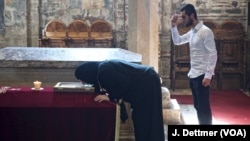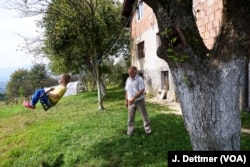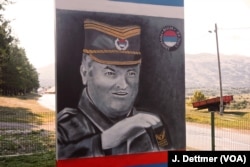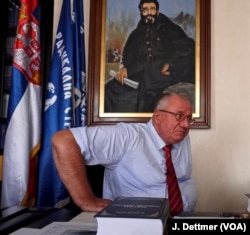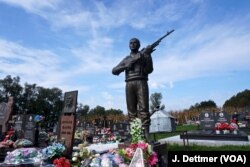There is no trust in the Balkans.
Families from the different ethnic groups — Serb, Croat, Bosniak and ethnic Albanians — who live close together in villages that suffered massacres in the Balkan wars of the 1990s still do not look each other in the eye and do not mix socially.
In Ahmići, one of the villages in the picturesque Lašva Valley where Croats sought to drive out in 1993 Bosnian Muslims — known as Bosniaks, an estimated 120 were slaughtered. Bosniak and Croat children attend separate schools. Huso Ahmići, now 72 years old, lost his parents in the assault on the village. “It is as if it happened yesterday,” he told VOA.
We spent a morning with Huso and his wife in the garden he played in as a boy. The family home was razed to the ground in the 1993 assault and Huso’s parents died in the blaze. He rebuilt the house, now both a home and a grave.
A two-minute walk away is the house of one of the Croat commanders convicted of war crimes by the UN’s International Criminal Tribunal for the Former Yugoslavia. He lives mainly now in the Croatian capital Zagreb since his release from jail but is occasionally spotted in Ahmići. Local Bosniaks do not speak with him. They do belabor a ‘good morning’ when encountering any of the other 55 Croats living in the village.
“Our courtesy is a way of punishing them,” says Huso.
As we talked overlooking the now peaceful Lašva Valley it was hard to picture the carnage that happened on April 16, 1993. The village came under a meticulously planned assault from three sides with the only apparent escape route covered by carefully positioned snipers.
Now Huso’s grandson plays where he once did, scattering several cats as he shows me how he’s “Sonic Boy,” despite wearing a yellow "Ninja Turtle" T-shirt.
T-shirts, and not the innocuous kind, are the latest way for a new generation of ultra-nationalists in the Balkans to express their disdain for rival ethnic groups. In the Croatian city of Split, a shop called Patriot Hrvatska sells shirts with nationalist and fascist motifs that evade broad legislation against hate-mongering, according to the news site Balkan Insight.
Among the wares are shirts celebrating the World War II fascist Ustasa movement. One sports a stylized letter U which is incorporated into a Smiley-face emoticon. Other shirts use subtly disguised motifs of the Croatian Defense Forces, a 1990s paramilitary unit that drew on the Ustasa for bestial inspiration.
In Serbia, too, you can buy offensive T-shirts, including those printed with the image of Bosnian Serb leader Radovan Karadzic, who was convicted by The Hague court and sentenced to 40 years in prison for genocide and other war crimes. He is appealing the ruling.
Serbian law bans the propagation or justification of the ideas or wartime actions of individuals convicted of war crimes, but the law is not enforced. That is hardly surprising considering the current President of Serbia, Aleksandar Vučić, lauds Serb wartime leader Slobodan Milošević as a “great leader.”
History is a battlefield, not as bloody as the real thing, but with consequences that can be.
The Balkan region has seen its fair share of historical revisionism. Croatia’s wartime leader Franjo Tudjman devoted decades after his retirement in 1961 from the Communist-era Yugoslav army to "historical" research, taking issue especially with the well-documented claims that Croatia’s Nazi-backed Ustasa regime during World War II committed gross war crimes against the Serbs and others. It was all an exaggeration by the Communists, Tudjman said.
For Tudjman, Croats could not possibly commit war crimes during either World War II or the Balkans wars of the 1990s as Yugoslavia fractured because they were engaged in a glorious endeavor. “Croatian men liberating their country from evil, cannot be held accountable,” he once said. For him war crimes could only be committed by Serbs.
Fast forward to now. Serbian opposition leader Vojislav Šešelj told me he is engaged on a monumental three-volume work with the aim of proving that the 1995 Srebrenica massacre of more than 8,000 Bosniaks, mainly men and boys, was not an act of genocide by Serbs.
The slaughter was the handiwork of units of the Bosnian Serb Army of Republika Srpska under the command of Ratko Mladić and a paramilitary unit known as the Scorpions from Serbia.
“It wasn’t genocide because they let the women go,” he said. He did have the courtesy to acknowledge in a lowered voice that it “was a war crime.” Maybe Šešelj, who cursed out The Hague judges, is mellowing. Šešelj was found guilty by the U.N. court of crimes against humanity for instigating the deportation of Croats from the village Hrtkovci in May 1992.
Srebrenica was officially recognized as genocide by the U.N. war crimes tribunal at The Hague.
Many of the young, mostly educated middle-class, prefer not to think of the recent conflict, seeing it as ancient history. Their eyes are on the future, one they associate almost exclusively with the European Union, which they are eager to join.
That hope is even harbored by the Russia-friendly and hardline nationalist President of Bosnia Serbia, otherwise known as Republika Srpska — despite his courting of former Donald Trump adviser, Steve Bannon, who has started a new project, called The Movement, which aims to help right wing populists nationalists across the European continent.
“The one person we don’t need in the Balkans right now is Bannon,” says a European diplomat based in Belgrade.
Whether enlargement happens, and Bosnia, Serbia, Kosovo, and Macedonia ever enter the EU is another question. In May, French President Emmanuel Macron slammed the brakes, cautioning that the bloc is weighed down with other issues and noting that enlargement has caused peril in the past. Inclusion of the Balkan states would have to be scrutinized with “a lot of prudence and rigor,” he said. The EU has postponed formal ascension talks for Macedonia.
The young already are voting with their feet, grabbing visas where they can. According to U.N. figures, Bosnia has the highest percentage of its people emigrating of any European state. Neighboring Balkan states also are experiencing massive outflows: 10 percent of Croatian schools have no students.
Working-class kids born after the war are more likely to nurse nationalist ideas and wear the T-shirts glorifying past ethnic warlords, a way maybe of finding meaning for lives stunted by lack of opportunities.
Branislav Borenović, an opposition politician in Bosnia Serbia, tells me he fears the young want “easy answers” for their jobless plight and are being manipulated by nationalist politicians who have vested interests in maintaining the divisions and explaining away stalled progress as the fault of internal enemies, the other ethnic groups.
“People don’t feel secure, they are fearful and they don’t want to be scared,” he says.
Historical resentments and anger simmer across the Balkans. Landscapes hardly bear signs of the ferocious conflict that left no less than 133,000 dead. The Bosnian city of Mostar, which saw vicious fighting in the 1990s, and Sarajevo, the Bosnian capital, are unusual because they continue to bear the scars of war. Many of Sarajevo’s older buildings remain pockmarked by bullet holes, standing beside sparkling new office buildings funded by overseas investors.
The landscapes and townships may appear free of the wars of the 1990s but the war generations are caught in the remembrance of things past. They remain injured and will be forever. Untold stories remain to be told but are still buried because of the pain of narration.
We pass through the town of Foča in Republika Srpska on the banks of the clear waters of the river Drina. Here Serbian paramilitary established a "rape camp" in which hundreds of Bosniak women were brutalized. Among them a woman who was repeatedly raped by one particular commander. The commander’s brother helped her to flee.
They met many years later at the instigation of the woman, who wanted to thank her rescuer. Neither will go public with their story — the man for fear of being seen as a traitor; the woman, because her story is too painful to tell.




